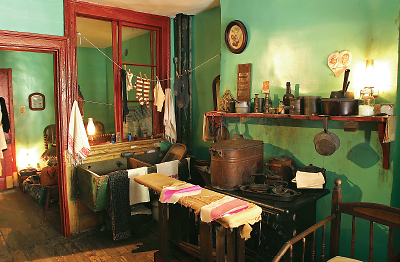Tenement Museum Brings America’s Immigrant Story to Life
Abstract
Restored multifamily dwellings depict life in the tenements when it is believed New York’s Lower East Side was the most densely populated location in the world.
The immigrant experience was and still is an important part of the American experience.
And the flood of immigrants who settled in New York’s Lower East Side in the 19th and early 20th centuries was the source of brains, manpower, and ambition that helped to transform America into a global superpower. The tenement buildings of Manhattan where they first settled—cramped, often unsafe, multiple-family dwellings—were the first American homes of immigrants often struggling to learn a new language and customs while trying to make a new life and raise a family with limited means.
The Tenement Museum preserves and interprets the history of immigration as it was experienced in one seemingly ordinary building at 97 Orchard Street. Erected on Manhattan’s Lower East Side in 1863, this tenement apartment building housed a total of nearly 7,000 working-class immigrants before it was vacated n 1941.
The original building contained 20 three-room apartments, arranged four to a floor, two in front and two in the rear. Each totaled only 325 square feet and consisted of a front room—the only room that received direct light and ventilation—bedroom, and kitchen. Cutting through the center of the building was an unlighted, ventilated wooden staircase.
There are three ways visitors to New York can experience the Tenement Museum—by touring the building at scheduled walking tour times; meeting the residents (played by costumed interpreters) who lived at 97 Orchard Street; and walking the neighborhood and discovering the Lower East Side and the way immigrants helped shaped the area and its culture.
The building tours are centered around five main themes: “Shop Life,” on the ground floor of the museum, explores the family-run stores that filled the lower level of 97 Orchard; “Irish Outsiders,” on the fourth floor, allows visitors to experience the immigrant saga through the music of Irish America, then tour the restored apartment of the Moore family, Irish-Catholic immigrants; “Sweatshop Workers,” on the third floor, replicates the Levine family garment workshop and the Rogarshevskys’ Sabbath table at the turn of the 20th century; “Hard Times,” on the second floor, shows how immigrants survived economic depressions at 97 Orchard Street between 1863 and 1935; and “Exploring 97 Orchard,” on multiple floors and offered only on Thursdays, which allows visitors to go behind the scenes at the Tenement Museum and explore the layers of history in the tenement’s physical fabric.
Two of the tours—“Hard Times” and “Sweatshop Workers”—also have extended three-hour versions that include a discussion following the tour.

This is a replication of the kitchen of the Levine family, who lived at 97 Orchard Street in the 1890s.
The Tenement Museum is the brainchild of Ruth Abram, an historian and social activist, who wanted to build a museum to honor America’s immigrants. In the late 1980s she and fellow-founder Anita Jacobsen stumbled upon the 97 Orchard building, in which they found the remnants of dilapidated apartment dwellings from the early 20th century, including sheet-metal ceilings, an old wooden staircase bannister, and turn-of-the-century toilets. “It was as though people had just picked up and left,” Jacobson is quoted as saying on the museum’s website. “It was a little time capsule. . . . I called Ruth and said ‘We have got to have this building.’ It was perfect.”
Researchers scavenged through 97 Orchard and combed through archives, compiling evidence about tenants and tenement life. In 1992 the Museum opened its first restored apartment, the 1878 home of the German-Jewish Gumpertz family.
The museum continues to expand. In January, museum leaders announced plans for new permanent exhibits exploring the stories of Chinese immigrants, Jewish Holocaust survivors, and Puerto Rican migrants who began new lives on the Lower East Side after World War II. The museum will honor the experiences of these more recent immigrants in conjunction with the German, Irish, Italian, and Eastern European immigrant stories that it currently interprets.
“Now more than ever, the Tenement Museum’s mission and work are deeply relevant,” said Museum President Morris J. Vogel in a statement on the museum website. “The story of our nation’s immigrants is America’s defining narrative, and the joys and challenges of establishing new lives and new communities continue for present-day immigrants around the world. We’re proud and excited that we’ll soon be able to explore a wider range of these stories for a larger audience.” ■
More information on the Tenement Museum is posted at http://www.tenement.org.



